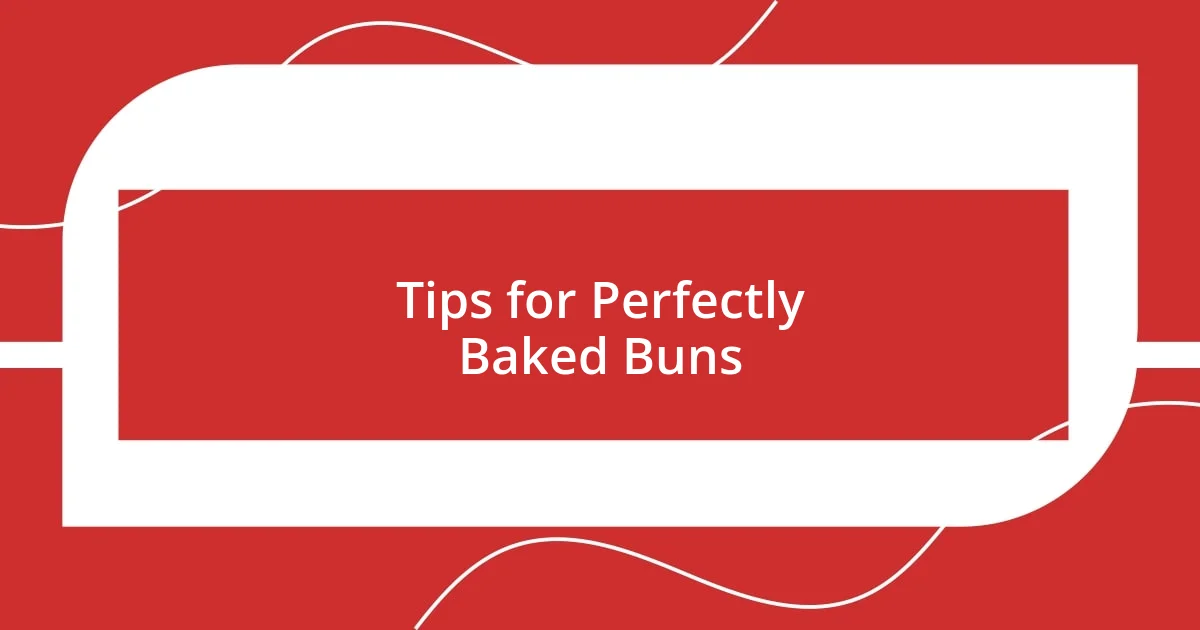Key takeaways:
- Homemade burger buns offer unmatched freshness, customization, and great texture, enhancing the overall meal experience.
- Key ingredients for successful buns include flour (for structure), yeast (for fluffiness), and warm water (to bind and activate yeast).
- To ensure perfect buns, allow adequate rising time, bake at the right temperature, and consider adding toppings or herbs for added flavor and visual appeal.

Introduction to Homemade Burger Buns
There’s something incredibly satisfying about biting into a homemade burger bun. I remember the first time I decided to make them from scratch; the smell of fresh dough filled my kitchen, and I couldn’t help but feel a sense of nostalgia and excitement. Could anything be more rewarding than serving a burger on a bun you crafted with your own hands?
Creating homemade burger buns allows for a level of personalization that store-bought options just can’t match. I often think about how the right bun can take a meal from ordinary to extraordinary. The moment I realized that I could experiment with toppings, flavors, and textures, it was like opening up a world of culinary possibilities right in my own kitchen.
In my experience, the joy of making burger buns is not just about the process; it’s about sharing them with loved ones. Picture this: a sunny afternoon, friends gathered around, laughter echoing as they bite into those soft, fluffy buns. Isn’t that what cooking is all about? The culmination of flavors and memories, wrapped in a simple yet delicious creation.

Why Make Your Own Buns
Making your own burger buns is not just a culinary task; it’s an adventure. There’s an unmatched joy in kneading the dough yourself, and I vividly recall my kitchen becoming a mini-laboratory filled with flour clouds and bubbling yeast. The anticipation of watching those little dough balls rise is exhilarating and gives a sense of achievement that store-bought options simply can’t replicate.
Here are a few reasons why you should consider embarking on this delicious journey:
- Freshness: Homemade buns are fresher and free from preservatives, making them tastier and healthier.
- Customization: You control the ingredients, so you can experiment with whole grains, herbs, or even spices for unique flavors.
- Texture: The satisfaction of achieving that perfect fluffy and soft texture, tailored to your burger type, is incredibly rewarding.
- Cost-effective: It’s often more economical to make them at home, especially when feeding a crowd.
- Fun Experience: Getting hands-on in the kitchen is a fun way to bond with family and friends, making the process memorable.

Essential Ingredients for Burger Buns
The essential ingredients for homemade burger buns are quite straightforward, yet they come together to create something magical. Flour serves as the foundation; I love using all-purpose flour for its versatility, which gives the buns that ideal balance of fluffiness and structure. It’s amusing to think back on my initial attempt when I realized that flour plays a starring role, and without it, the buns would be less than perfect.
Then, there’s yeast, the true hero of the dough. Active dry yeast is my go-to; it’s both easy to use and dependable. I remember the first time I opened a packet of yeast, marveling at how such a tiny ingredient could make the dough rise and transform a simple mixture into soft, airy buns. It’s like watching a magic trick unfold right in your kitchen!
Another key player is warm water, which activates the yeast and serves as the glue that holds everything together. In my experience, ensuring the water is just the right temperature is crucial; too hot, and you risk killing the yeast, too cold, and it won’t activate. I fondly recall testing the water on my wrist, just like I’d seen my grandmother do, feeling a wave of nostalgia as I realized this little ritual was part of the baking magic.
| Ingredient | Purpose |
|---|---|
| Flour | Base structure for the buns |
| Yeast | Creates fluffiness through fermentation |
| Water | Activates yeast and binds ingredients |

Step-by-Step Bun Preparation
When it comes to preparing your burger buns, the first step is mixing the ingredients. I remember the first time I combined flour, yeast, and water, feeling the anticipation build as the mixture transformed into a shaggy dough. There’s a specific moment when it all comes together, and you just know you’ve got something special on your hands.
Once the dough is formed, it’s time to knead it until it’s smooth and elastic. This part always felt reminiscent of working out for me, like a mini exercise session in my kitchen! I found that a good 10 minutes of kneading really gives the dough the strength it needs. Have you ever felt that satisfying stretch and give in the dough? It’s that tactile feedback that assures you that you’re on the right path.
After kneading, I pop the dough into a greased bowl and cover it with a cloth to let it rise. It’s almost magical to peek under the cloth after an hour and see how much it has expanded. I still smile when I think back to my early attempts—watching the dough puff up felt like nurturing a little life! This rising step allows the flavors to develop, and it’s a gentle reminder of patience in the kitchen. Isn’t it fascinating how something so simple can bring such joy?

Tips for Perfectly Baked Buns
To achieve perfectly baked buns, ensure you don’t rush the rising process. I’ll never forget the time I was too impatient and decided to cut the first rise short. The result? Flat, sad-looking buns that lacked the airy quality I was aiming for. Now, I always allow the dough to double in size. That extra time is essential for flavor development and that glorious, fluffy texture.
Another tip I swear by is baking at the right temperature. I’ve learned through trial and error that a preheated oven is crucial. If the oven isn’t hot enough, you might end up with dense buns that resemble hockey pucks. Trust me, having the oven set to around 375°F (190°C) has been a game-changer for me.
Lastly, don’t forget to brush your buns with egg wash before they bake. The first time I tried this, I realized how it makes a world of difference. It gives the buns a beautiful golden-brown finish that’s simply irresistible. Have you ever pulled out warm, shiny buns from the oven and felt that sense of accomplishment? It’s those little touches that elevate homemade to extraordinary!

Customizing Your Burger Bun Recipe
Customizing your burger bun recipe can be as exciting as crafting the perfect burger patty. One of my favorite tweaks is adding herbs or spices right into the dough. The first time I included rosemary and garlic, my kitchen was filled with an aromatic symphony that had me grinning from ear to ear. Have you ever experimented with flavor infusions? It can completely change the character of your buns!
Another way to tailor your buns is by switching up the flour. I once used half whole wheat flour and half all-purpose flour, and it added a delightful nuttiness while still keeping that fluffy structure. Plus, I found that gluten-free flours work well too, although you may need to adjust the liquid content. Isn’t it fascinating how one small change can lead to a different texture and taste?
Lastly, consider the toppings before baking. I’ve started sprinkling sesame seeds or everything bagel seasoning on top of my buns right before they hit the oven. The first time I took that extra step, I was amazed at how it transformed them into something visually appealing and full of flavor. Have you tried this? It’s those finishing touches that can really elevate your homemade creation.

Storing and Freezing Your Buns
When it comes to storing your homemade burger buns, I’ve learned the best method is to let them cool completely before wrapping. The first time I made buns, I wrapped them too soon, and they ended up soggy—definitely not what I was aiming for! Now, I place them in an airtight container, which keeps them soft for a few days.
For longer storage, freezing is your best friend. I remember the first time I froze my buns, I was skeptical if they would retain their texture. To my surprise, they held up beautifully! I make sure to slice them beforehand, so I can grab just what I need without having to thaw the entire batch. Trust me; nothing beats popping a bun in the toaster straight from the freezer—it’s like having fresh-baked goodness on demand.
If you’re like me and love that homemade taste but need convenience, consider wrapping each bun in plastic wrap before sealing them in a freezer bag. I’ve found this method prevents freezer burn, preserving their quality. There’s something special about pulling out a freshly frozen bun and knowing you can recreate that warm, inviting smell of homemade baking with just a little effort. Have you tried this approach? Your future self will thank you!















